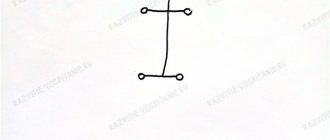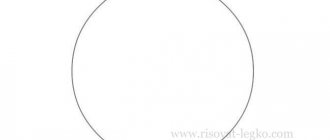Pedagogical project: “Everything about shoes” Middle group
Pedagogical project: “Everything about shoes”
in the middle group
The type
of project
is educational.
participants –
teachers, parents, children 4-5 years old.
duration –
short-term (November 16-20)
Project
manager : teacher of the highest category Ivanova Irina Aleksandrovna
Relevance
of the project
. Kindergarten teachers often observe how newly arriving children do not know how and do not want to put on their shoes independently and correctly, scatter them after a walk anywhere, and forget to put them in their locker. There are children who don't like their sandals and hide them. On the street they specifically “look” for dirt and puddles in order to “enjoy” such entertainment, without thinking that their mother will have to wash them, clean them, or even buy new ones. At the same time, many parents do not make efforts to change the situation, or their efforts do not lead to the desired result. There are parents who even believe that their children do not need this - the parents will take care of everything themselves: they will put on shoes, wash shoes, and buy new shoes. But in kindergarten there are different rules. Thus, a contradiction arises: on the one hand, the importance and necessity of familiarizing children with information about shoes, that they are needed and can be comfortable, beautiful, developing in children a careful attitude towards shoes, the ability to put them on themselves, and on the other hand, the lack purposeful, systematic work led to the choice of the project topic.
Objective of the project
: expand children’s knowledge about the concept of “Shoes”, cultivate a caring attitude towards their shoes; teach children to take care of their shoes: wipe their feet after a walk, put them back in their place, don’t get them dirty, don’t throw them around
Project objectives
.
— Introduce children to different types (children’s, sports, etc.)
and parts of shoes;
— consolidate knowledge about the purpose of shoes;
- connect shoes with the seasons;
— consolidate ideas about professions related to shoe production;
- give children an idea of the history of shoes;
- activate creative imagination;
— develop fine motor skills of children’s hands, memory, thinking and speech;
- increase children's cognitive interest;
- cultivate a careful, careful attitude towards your shoes and the shoes of others.
Expected Result.
-Children will develop knowledge about shoes, their purpose, use and care;
- children will learn to classify shoes (winter, children's, women's, men's, etc.).
— children will learn to draw, design, and cut out various shoe parts.
— an appropriate subject-development environment will be created; — parents’ activity in joint creative activities will increase.
Project
implementation stages .
Stage 1 – Preparatory.
— Defining the goals and objectives of the project.
— Collection of information: study of methodological and educational literature.
— Creation of conditions for organizing work on the project.
— Development of an action plan for organizing children's activities.
— A selection of teaching materials for working with children.
— Discussion with parents about the topic of the project.
— Determining the degree of parental participation in the project implementation
Stage 2 – practical.
Implementation of the project in accordance with the comprehensive thematic plan of educational activities.
1.Conversations:
“Where do shoes come from and who makes them?”, “Comfortable shoes”, “Why do we wear Czech shoes for exercise and physical education?”, “Where should we buy shoes?”, “Do we need shoes?”.
2.
Literary word:
Reading the work of Sh. Galiev “Our boots are dancing”, A. Barto “Shoes”, E. Blaginin “I know how to put on shoes”, the poem “Centipede” by T. Dergunova. Watch a cartoon on the topic “Miracle Tree”.
3.
GCD.
Knowledge of the surrounding world. “Shoes” - to form ideas about the variety of footwear items and their purpose. Continue to introduce children to different materials. Talk about making shoes. Introduce the profession of a shoemaker.
Speech development. “Long live Tuflyandiya!” —
involve in playful and verbal interaction with peers, role-playing dialogue; activate verbs, names of shoes; stimulate games with words and sounds, word creation; develop diction and articulatory apparatus.
Art. Drawing. “Centipede” - strengthen the ability to draw circles, learn to coordinate the proportions of the paper (background) and the intended image.
Art. Modeling. “Miracle - Tree” - continue to master plastic methods of creating images based on a ball and a cylinder
4. Productive activity:
Drawing “Fashionable shoe salon”
Application "Miracle tree".
Modeling - bas-relief “Magic Boots”.
5. Sports exercise
“My magic shoe”, ball game: “Say kindly”, sports relay race “Boots”, “Pack up a doll for a walk”,
active game “Don’t get your feet wet”, sedentary game “1,2,3,4,5! We must quickly run into the circle!”
6.Didactic games
: “Let’s lace up our shoes”, “Winter or summer”, “What boys and girls wear”, “Choose shoes for exercise”, “Find five differences”, lotto “Shoes”, “Collect a cut picture”, “Collect a picture according to the sample” , “Name which ones” and others - to update and supplement children’s knowledge about what material various objects are made of; teach correctly, use appropriate adjectives in speech; develop grammatical structure of speech and enrich vocabulary.
7. Plot-role-playing games:
“Shoe store”, “Shoe shop” - help children use familiar play actions.
8.
Household work
- to develop the ability in children to notice disorder in clothes, put their shoes in order, develop the appropriate skills, teach them to help each other: “We teach the Sloppy to wash boots and shoes.”
9.
Theatrical activity
: Composing a fairy tale “The Journey of Boots” with playing out the plot.
10. Experimental activities
“Look at pieces of different fabrics, find differences” - develop fine motor skills through tactile sensations; develop the ability to distinguish between materials.
11. Construction games
“Building a clothing store” - to develop children’s skills to carry out large-scale construction collectively, to coordinate their actions with the actions of other players; ability to beat the construction
12. Consultations for parents
on the topic of the week “How to choose shoes for a child”, “Together we teach children”
The final stage.
Exhibition of children's works.
Comprehensive thematic plan.
As a result of the project :
Children learned the history of creating shoes, their meaning, methods of making; learned how to design and cut out parts of shoes and fabric; learned to write stories based on object pictures
.Thanks to this project, parent-child relationships have been strengthened; horizons expanded; The level of moral culture of parents has increased. We equipped the subject-development environment through the production of didactic games and visual materials.
Summary of educational activities for speech development in the middle group on the topic “Looking at shoes”
Children: Made of rubber.
Educator: When do we put on rubber boots?
Children: When it rains, there are puddles and mud on the street.
Educator: Think, why not leather?
Children: Leather ones will get wet, but rubber ones won’t.
Educator: That's right, well done! Let me explain - rubber boots are worn in rainy weather, slushy weather, when it is raining outside, there are a lot of puddles. Guys, think about it, what time of year does this weather happen?
Children: Autumn and spring.
Educator: That's right, it rains in the fall, and in the spring the snow melts, many puddles and streams form. This time of year is called the off-season. And shoes worn in autumn and spring are called off-season. (Individual and choral answers.) Now let's look again at the absent-minded one from Basseynaya Street. He has a rubber boot on one foot and a leather boot on the other. Tell me, how are they similar, what do they have the same?
Children: Boots have a sole, a toe, a heel, and a shaft; they are put on your feet.
Educator: Now look at them and find out how the boots differ?
Children: Some boots are leather, others are rubber; some are off-season, others are winter; some are black, others are blue.
Educator: Well, absent-minded from Basseynaya Street, now you understand that you need to wear paired shoes according to the season?
Absent-minded from Basseynaya Street: Thank you, guys! Without you, it would be very difficult for me to figure everything out. And now I understand everything and immediately put on paired rubber shoes. And it’s raining outside today and there are puddles all around. Thank you guys! I must go, goodbye!
Educator: Guys, I have prepared a surprise for you! But you just need to find him. Let's play the game "Warm and Cold".
The children find a beautiful box tied with a red ribbon and a big red bow.
Educator: What do you think is there? (Children's answers).
Now I’ll tell you a riddle, and you can guess it.
We always play together, We look like brothers, We are under the table at dinner, And under the bed at night.
Children: Shoes.
Educator: That's right, these are shoes. Look at them, what color are they?
Children: Red.
Educator: What do they have?
Children: Sole, toe, heel.
Educator: What else is there?
Children: Strap, buckle.
Educator: The buckle is iron, they fasten it on it so that they do not fall off the leg. When are they worn?
Children: In the summer. These are summer shoes.
Educator: Guys, who will tell you everything about the shoes? (Children make up a story according to plan.)
1What is this?
2.What are they?
3.What are they for?
Children: These are shoes. They are red and shiny. They have a sole, toe, heel, strap and buckle. Shoes are worn in the summer, these are summer shoes.
Educator: Now let's play! There are two pictures hanging in front of you. One depicts autumn, and the other summer. Now listen to the music and determine which picture you need to run to (the music director plays rainy music first, and then the sun comes out).
Publication address:




